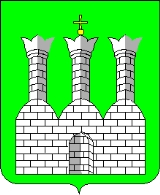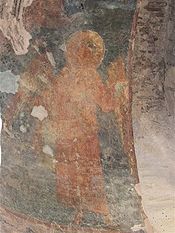
Oster
Encyclopedia

City
A city is a relatively large and permanent settlement. Although there is no agreement on how a city is distinguished from a town within general English language meanings, many cities have a particular administrative, legal, or historical status based on local law.For example, in the U.S...
located where the Oster River
Oster River
The Oster River is a river in the northern Ukrainian oblast of Chernihiv. The river is the left branch of the Desna River. It is approximately 199 km long and its basin area is 2,950 km². It is connected by canals and streams with the Trubizh River, which flows southwest from Kiev into...
flows into the Desna in Chernihiv Oblast
Chernihiv Oblast
Chernihiv Oblast is an oblast of northern Ukraine. The administrative center of the oblast is the city of Chernihiv.-Geography:The total area of the province is around 31,900 km²....
of Ukraine
Ukraine
Ukraine is a country in Eastern Europe. It has an area of 603,628 km², making it the second largest contiguous country on the European continent, after Russia...
. As of January 1, 2005, its population is 7,100.
Today Oster is a river port with a cotton-textile factory and a food industry. Some parts of the old fortress in Oster and the remains of the tiny Saint Michael's Church (a.k.a. Yurii's Temple, the only preserved church of the medieval principality of Pereyaslav), which was constructed in 1098, have fortunately been preserved.

History
Oster was founded in 1098 by Vladimir MonomakhVladimir II Monomakh
Vladimir II Monomakh |Basileios]]) was a Velikiy Kniaz of Kievan Rus'.- Family :He was the son of Vsevolod I and Anastasia of Byzantium Vladimir II Monomakh |Basileios]]) (1053 – May 19, 1125) was a Velikiy Kniaz (Grand Prince) of Kievan Rus'.- Family :He was the son of Vsevolod I (married in...
as Gorodets, a fortress belonging to Pereiaslav principality, which was later inherited by his son Prince
Prince
Prince is a general term for a ruler, monarch or member of a monarch's or former monarch's family, and is a hereditary title in the nobility of some European states. The feminine equivalent is a princess...
Yuri Dolgoruki
Yuri Dolgoruki
Prince Yuri I Dolgorukiy , also known as George I of Rus, was the founder of Moscow and a key figure in the transition of political power from Kiev to Vladimir-Suzdal following the death of his elder brother Mstislav the Great...
. In 1240, it was destroyed by the Mongol invasion
Mongol invasion of Rus
The Mongol invasion of Russia was resumed on 21 December 1237 marking the resumption of the Mongol invasion of Europe, during which the Mongols attacked the medieval powers of Poland, Kiev, Hungary, and miscellaneous tribes of less organized peoples...
, after which it remained in ruins for a century. After the destruction of the fort, a village arose in its place, named Stary Oster or Starogorodkaya. In the beginning of the 14th century a newer settlement arose closer to the Desna, named Oster.
Since 1356 Oster was under control of the Grand Duchy of Lithuania
Grand Duchy of Lithuania
The Grand Duchy of Lithuania was a European state from the 12th /13th century until 1569 and then as a constituent part of Polish-Lithuanian Commonwealth until 1791 when Constitution of May 3, 1791 abolished it in favor of unitary state. It was founded by the Lithuanians, one of the polytheistic...
, later, under the Union of Lublin
Union of Lublin
The Union of Lublin replaced the personal union of the Kingdom of Poland and the Grand Duchy of Lithuania with a real union and an elective monarchy, since Sigismund II Augustus, the last of the Jagiellons, remained childless after three marriages. In addition, the autonomy of Royal Prussia was...
, and from 1569 Oster was part of the Polish-Lithuanian Commonwealth
Polish-Lithuanian Commonwealth
The Polish–Lithuanian Commonwealth was a dualistic state of Poland and Lithuania ruled by a common monarch. It was the largest and one of the most populous countries of 16th- and 17th‑century Europe with some and a multi-ethnic population of 11 million at its peak in the early 17th century...
. In 1648 it became part of an uyezd
Uyezd
Uyezd or uezd was an administrative subdivision of Rus', Muscovy, Russian Empire, and the early Russian SFSR which was in use from the 13th century. Uyezds for most of the history in Russia were a secondary-level of administrative division...
of the Pereiaslav regiment. Since 1654, Oster was under control of the Russian Empire
Russian Empire
The Russian Empire was a state that existed from 1721 until the Russian Revolution of 1917. It was the successor to the Tsardom of Russia and the predecessor of the Soviet Union...
. In 1622, King
Monarch
A monarch is the person who heads a monarchy. This is a form of government in which a state or polity is ruled or controlled by an individual who typically inherits the throne by birth and occasionally rules for life or until abdication...
Jan II Casimir granted Oster the Magdeburg rights
Magdeburg rights
Magdeburg Rights or Magdeburg Law were a set of German town laws regulating the degree of internal autonomy within cities and villages granted by a local ruler. Modelled and named after the laws of the German city of Magdeburg and developed during many centuries of the Holy Roman Empire, it was...
and a coat of arms. After harsh battles of the Ukrainian War for Independence, the Polish rule was again established in Oster, but in February of 1664, with support from the local population, the Poles were driven back by Cossacks and the Russians. In 1803, the city became an uyezd center of Chernigov Gubernia
Chernigov Governorate
The Chernigov Governorate , also known as the Government of Chernigov, was a guberniya in the historical Left-bank Ukraine region of the Russian Empire, which was officially created in 1802 from the disbanded Malorossiya Governorate with an administrative centre of Chernigov...
.

